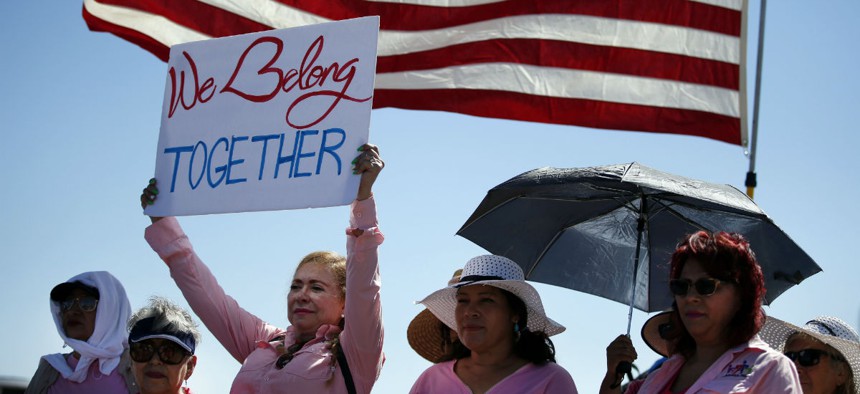
Andres Leighton / AP
The Trump Administration Is Struggling to Reunify Young Separated Immigrants With Their Parents
ICE maintains the steps it has taken are in compliance with a federal court mandate.
The Trump administration has reunited just four of 102 separated immigrant children younger than five years old with their parents as of Tuesday, according to documents it filed in federal court, putting it at risk of violating a judge’s order.
Immigration and Customs Enforcement expected to reunite an additional 34 young children with their parents by the Tuesday deadline. The reunifications became necessary after the administration in May implemented its “zero tolerance” policy that forced the separations. Last month, a federal judge in California issued a preliminary injunction ending the family separations and setting a tight time frame for bringing them back together. The government will face another deadline in two weeks to reunite the remaining nearly 3,000 children in its charge.
In addition to the 38 children under five ICE expected to reunite with their parents on Tuesday, 16 are expected to be returned as soon as ICE confirms parentage. Those parents have already cleared a criminal background check.
Twenty children cannot be reunited because of “legitimate logistical impediments.” In 12 of those cases, ICE has already deported the parents. The government vowed to work with their attorneys to send those children back to their home countries if the parents elect that option. The parents of the other eight children were released into the United States and ICE is working to screen them.
In 14 cases, the children’s parents had a “serious criminal history” and therefore were not eligible to be reunited. In five cases, the alleged parents were determined not to be the actual mother or father. In one case, ICE found “credible evidence” of child abuse. In 12 other instances, the parents were ineligible for reunification because of issues with their household, they were sick or they were in custody of other law enforcement agencies.
One child’s parent has not been located for more than one year, ICE said, and the child might be a U.S. citizen.
ICE said the work it has so far accomplished has brought the agency in compliance with the court’s order. The American Civil Liberties Union, which brought the suit, said it could not independently verify the government’s information. Even using the available data, however, ACLU said ICE was not in compliance. The group said ICE should have taken more steps to reunite parents with their children before they were deported and more quickly reunited children with parents released in the country.
A judge said on Tuesday ICE should expedite the vetting process it uses before reuniting children with parents. The two sides were set to continue meeting on Tuesday to work out further agreements on how to proceed with the reunification process.
Health and Human Services Department Secretary Alex Azar last week could not say exactly how many children HHS has in its care, but suggested it was near 3,000. Customs and Border Protection typically makes the arrests of immigrants illegally crossing the border. Immigration and Customs Enforcement detains the parents and HHS finds sponsors to house children or places them in department facilities.
Azar recently testified to Congress that he can find any separated child “within seconds” in a database HHS maintains in conjunction with the Homeland Security Department. That database, according to DHS, includes how the minors “illegally entered the country” and, “to the extent possible,” information about and the location of the minor’s parent or guardian. Azar acknowledged last week some children’s entries in the database do not accurately reflect whether they were separated from a parent upon entering the country.







